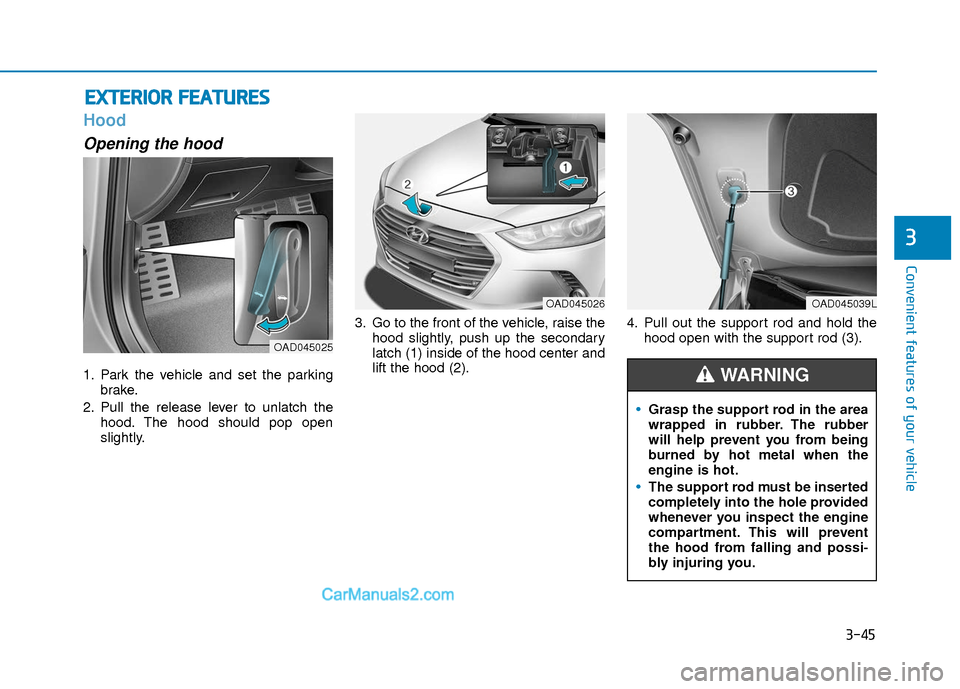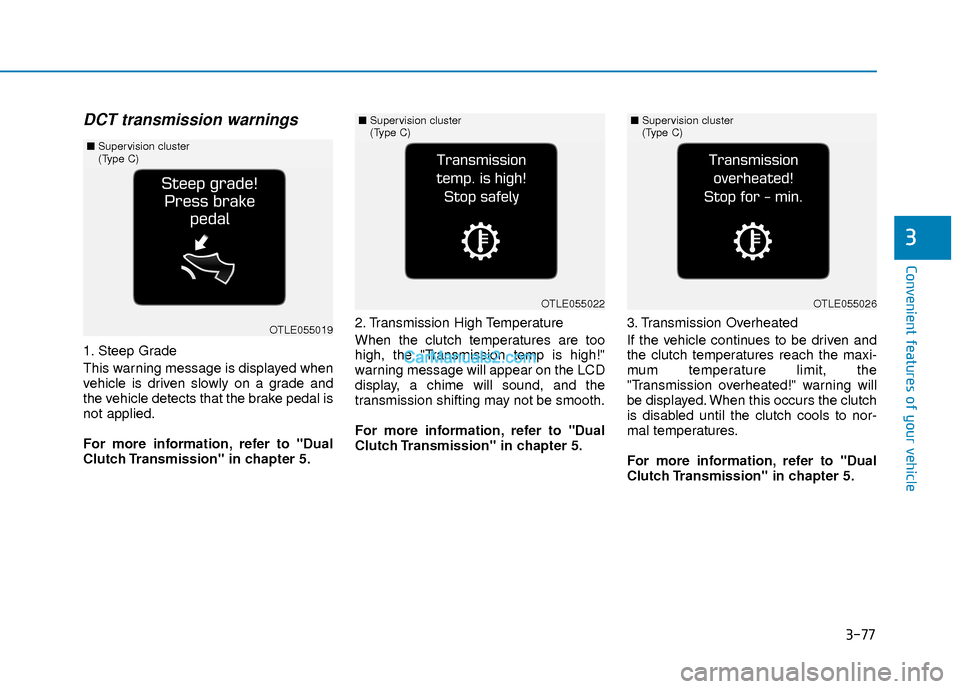2018 Hyundai Elantra brake
[x] Cancel search: brakePage 122 of 526

3-45
Convenient features of your vehicle
3
E
EX
X T
TE
ER
R I
IO
O R
R
F
F E
E A
A T
TU
U R
RE
ES
S
Hood
Opening the hood
1. Park the vehicle and set the parking
brake.
2. Pull the release lever to unlatch the hood. The hood should pop open
slightly. 3. Go to the front of the vehicle, raise the
hood slightly, push up the secondary
latch (1) inside of the hood center and
lift the hood (2). 4. Pull out the support rod and hold the
hood open with the support rod (3).
OAD045025
OAD045039L
Grasp the support rod in the area
wrapped in rubber. The rubber
will help prevent you from being
burned by hot metal when the
engine is hot.
The support rod must be inserted
completely into the hole provided
whenever you inspect the engine
compartment. This will prevent
the hood from falling and possi-
bly injuring you.
WARNING
OAD045026
Page 129 of 526

3-52
Convenient features of your vehicle
Closing the fuel filler door
1. To install the fuel tank cap, turn itclockwise until it "clicks" one time.
2. Close the fuel filler door until it is latched securely.
Gasoline is highly flammable and
explosive. Failure to follow these
guidelines may result in SERIOUS
INJURY or DEATH:
Read and follow all warnings
posted at the gas station.
Before refueling, note the loca-
tion of the Emergency Gasoline
Shut-Off, if available, at the gas
station.
Before touching the fuel nozzle,
you should eliminate the poten-
tial build-up of static electricity
by touching a metal part of the
vehicle, a safe distance away
from the fuel filler neck, nozzle, or
other gas source, with your bare
hand. (Continued)
WARNING
(Continued)
Do not use cellular phones while
refueling. Electric current and/or
electronic interference from cel-
lular phones can potentially
ignite fuel vapors and cause a
fire.
Do not get back into a vehicle
once you have begun refueling.
You can generate a build-up of
static electricity by touching, rub-
bing or sliding against any item
or fabric capable of producing
static electricity. Static electricity
discharge can ignite fuel vapors
causing a fire. If you must re-
enter the vehicle, you should
once again eliminate potentially
dangerous static electricity dis-
charge by touching a metal part
of the vehicle, away from the fuel
filler neck, nozzle or other gaso-
line source, with your bare hand.
When using an approved
portable fuel container, be sure to
place the container on the
ground prior to refueling. Static
electricity discharge from the
container can ignite fuel vapors
causing a fire.(Continued)
(Continued)Once refueling has begun, con-
tact between your bare hand and
the vehicle should be maintained
until the filling is complete.
Use only approved portable plastic
fuel containers designed to carry
and store gasoline.
When refueling, always move the
shift lever to the P (Park) posi-
tion, set the parking brake, and
place the ignition switch to the
LOCK/OFF position. Sparks pro-
duced by electrical components
related to the engine can ignite
fuel vapors causing a fire.
Do not use matches or a lighter
and do not smoke or leave a lit
cigarette in your vehicle while at
a gas station, especially during
refueling.
Do not over-fill or top-off your
vehicle tank, which can cause
gasoline spillage. (Continued)
Page 139 of 526

3-62
Convenient features of your vehicle
Parking Brake & Brake Fluid
Warning Light
Driving the vehicle with a warning
light ON is dangerous. If the
Parking Brake & Brake Fluid
Warning Light illuminates with the
parking brake released, it indicates
that the brake fluid level is low.
In this case, have your vehicle
inspected by an authorized
HYUNDAI dealer.
WARNING
Seat Belt Warning Light
This warning light informs the driver that
the seat belt is not fastened.
For more information, refer to the
"Seat Belts" in chapter 2.
Parking Brake & BrakeFluid Warning Light
This warning light illuminates:
Once you set the ignition switch or the
Engine Start/Stop button to the ON
position.
- It illuminates for approximately 3 sec-onds.
- It remains on if the parking brake is applied.
When the parking brake is applied.
When the brake fluid level in the reser- voir is low.
- If the warning light illuminates withthe parking brake released, it indi-
cates the brake fluid level in reservoir
is low.
If the brake fluid level in the reser-
voir is low:
1. Drive carefully to the nearest safe location and stop your vehicle.
2. With the engine stopped, check the brake fluid level immediately and add
fluid as required (For more informa-
tion, refer to "Brake Fluid" in chap-
ter 7). After adding brake fluid, check
all brake components for fluid leaks. If
a brake fluid leak is found, or if the
warning light remains on, or if the
brakes do not operate properly, do not
drive the vehicle. Have the vehicle
inspected by an authorized HYUNDAI
dealer.
Dual-diagonal braking system
Your vehicle is equipped with dual-diago-
nal braking systems. This means you still
have braking on two wheels even if one
of the dual systems should fail.
With only one of the dual systems work-
ing, more than normal pedal travel and
greater pedal pressure is required to stop
the vehicle. Also, the vehicle will not stop in as short
a distance with only a portion of the
brake system working.
If the brakes fail while you are driving,
shift to a lower gear for additional engine
braking and stop the vehicle as soon as
it is safe to do so.
Page 140 of 526

3-63
Convenient features of your vehicle
3
Anti-lock Brake System(ABS) Warning Light
This warning light illuminates:
Once you set the ignition switch or the
Engine Start/Stop button to the ON
position.
- It illuminates for approximately 3 sec-onds and then goes off.
When there is a malfunction with the ABS (The normal braking system will
still be operational without the assis-
tance of the anti-lock brake system).
In this case, have your vehicle inspect-
ed by an authorized HYUNDAI dealer.
ElectronicBrake ForceDistribution(EBD) System Warning Light
These two warning lights illuminate
at the same time while driving:
When the ABS and regular brake system
may not work normally.
In this case, have your vehicle inspected
by an authorized HYUNDAI dealer.
Information - Electronic Brake
Force Distribution (EBD) System
Warning Light
When the ABS Warning Light is on or
both ABS and Parking Brake & Brake
Fluid Warning Lights are on, the
speedometer, odometer, or tripmeter may
not work. Also, the EPS Warning Light
may illuminate and the steering effort may
increase or decrease.
In this case, have your vehicle inspected by
an authorized HYUNDAI dealer.
Electronic Power Steering (EPS)Warning Light
This warning light illuminates:
Once you turn the ignition switch or the
Engine Start/Stop button to the ON
position.
- It illuminates for approximately 3 sec-onds and then goes off.
When there is a malfunction with the EPS.
In this case, have your vehicle inspect-
ed by an authorized HYUNDAI dealer.
i
Electronic Brake Force Distribution
(EBD) System Warning Light
When both ABS and Parking Brake
& Brake Fluid Warning Lights are
on, the brake system will not work
normally and you may experience
an unexpected and dangerous situ-
ation during sudden braking.
In this case, avoid high speed driv-
ing and abrupt braking.
In this case, have your vehicle
inspected by an authorized
HYUNDAI dealer.
WARNING
Page 143 of 526

3-66
Convenient features of your vehicle
This warning light remains ON
after blinking for approximately 60
seconds, or repeatedly blinks ON
and OFF in 3 second intervals:
When there is a malfunction with the
TPMS.
In this case, have your vehicle inspected
by an authorized HYUNDAI dealer.
For more information, refer to "Tire
Pressure Monitoring System (TPMS)"
in chapter 6.
Automatic EmergencyBraking (AEB) Warninglight (if equipped)
This warning light illuminates :
When the AEB system is turned off.
When the radar sensor or cover is
blocked with dirt or snow. Check the
sensor and cover and clean them by
using a soft cloth.
When there is a malfunction with AEB. In this case, have your vehicle inspect-
ed by an authorized HYUNDAI dealer.
Headlight WarningLight
This warning light illuminates:
This warning light illuminates if one of the
exterior bulbs (headlamp, taillamp,
foglamp, etc.) is not operating properly.
One of the bulbs may need to be
replaced. If the vehicle is equipped with
LED headlamps, have the vehicle
inspected by an authorized HYUNDAI
dealer.
Information
When replacing the bulb, use the same
wattage bulb.
For more information, refer to "BULB
WATTAGE" in chapter 8.
i
Safe Stopping
The TPMS cannot alert you to
severe and sudden tire damage
caused by external factors.
If you notice any vehicle instabili-
ty, immediately take your foot off
the accelerator pedal, apply the
brakes gradually with light force,
and slowly move to a safe posi-
tion off the road.
WARNING
Page 149 of 526

3-72
Convenient features of your vehicle
Press START button again
This message is displayed if you were
unable to start the vehicle when the
Start/Stop button was pressed.
If this occurs, attempt to start the engine
by pressing the Start/Stop button again.
If the warning message appears each
time you press the Start/Stop button,
have your vehicle inspected by an
authorized Hyundai dealer.
Press brake pedal to start engine
This warning message is displayed if the
Engine Start/Stop button changes to the
ACC position twice by pressing the but-
ton repeatedly without depressing the
brake pedal.
In order to start the vehicle, press the
brake pedal to start the engine.
Press START button with key
This warning message is displayed if you
press the Engine Start/Stop button while
the warning message "Key not detected"
is shown.
At this time, the immobilizer indicator
light blinks.
OTL045145L
■Supervision cluster
OTL045142LOTL045140L
■Supervision cluster ■Supervision cluster
Page 152 of 526

3-75
Convenient features of your vehicle
3
Sunroof open
This warning message is displayed if
you turn off the engine when the sunroof
is open.
Check BRAKE SWITCH fuse
This warning message is displayed if the
brake switch fuse is disconnected.
If this message is displayed, replace the
fuse with a new one before starting the
vehicle. If that is not possible, you can
start the engine by pressing the Engine
Start/Stop button for 10 seconds in the
ACC position.
Turn on "FUSE SWITCH"
This warning message is displayed if the
fuse switch under the steering wheel is
OFF.
If this message is displayed, turn the fuse
switch on.
For more information, refer to "Fuses"
in chapter 7.
OTL045147L
■Supervision cluster
OAD045160/OAD045137
■Conventional cluster■Supervision cluster
OAD045144/OTL045155L
■Conventional cluster ■Supervision cluster
Page 154 of 526

3-77
Convenient features of your vehicle
3
DCT transmission warnings
1. Steep Grade
This warning message is displayed when
vehicle is driven slowly on a grade and
the vehicle detects that the brake pedal is
not applied.
For more information, refer to "Dual
Clutch Transmission" in chapter 5.2. Transmission High Temperature
When the clutch temperatures are too
high, the "Transmission temp is high!"
warning message will appear on the LCD
display, a chime will sound, and the
transmission shifting may not be smooth.
For more information, refer to "Dual
Clutch Transmission" in chapter 5.
3. Transmission Overheated
If the vehicle continues to be driven and
the clutch temperatures reach the maxi-
mum temperature limit, the
"Transmission overheated!" warning will
be displayed. When this occurs the clutch
is disabled until the clutch cools to nor-
mal temperatures.
For more information, refer to "Dual
Clutch Transmission" in chapter 5.
OTLE055019
■
Supervision cluster
(Type C)
OTLE055022
■Supervision cluster
(Type C)
OTLE055026
■Supervision cluster
(Type C)